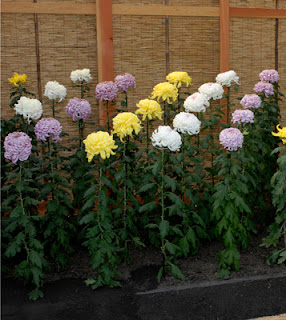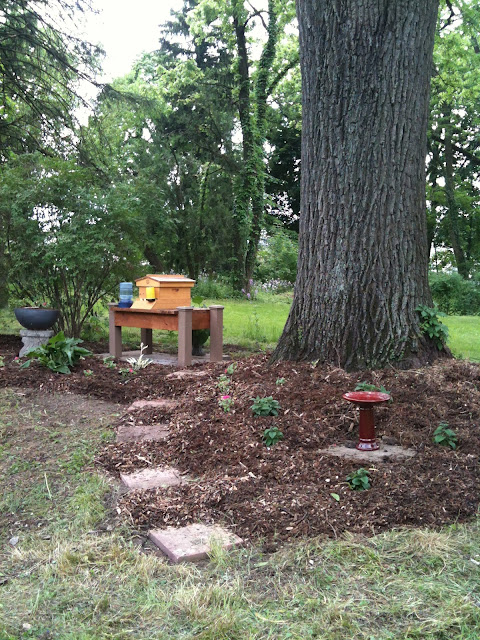Today we're celebrating the arrival of our very first honey bee colony! Bees are something that I've been interested in for many many years. Up until the move we didn't ever really have room to safely keep a hive around. This year I decided to go ahead and make the investment and get started. It takes a LOT of stuff to get set up, but like any hobby/project once you have the basic equipment it is fairly straightforward. You have to order everything in advance and place the bee orders in the winter, so I've literally been waiting for MONTHS for today.
So right off the bat I'll say that I was setting everything up by myself, in a light rain (bees hate rain), and trying to get done while there was still some daylight left, so the pictures are SKETCHY at best and taken with my phone.
 |
| Bee-hive stand |
The fist big decision was to figure out where to put the bees. They have a home on the "master plan" but the problem is that the area where they need to live eventually is right in the traffic lane for a couple of other as-of-yet-incomplete projects including replacing the shed. Since bees don't really appreciate a lot of noise and attention I figured it would probably be best if I put them somewhere else for the time being. The absolutely ideal place is down by the windmill, but as that's the lowest point in the yard and was under 3 feet of water during last September's flood I decided that probably wasn't the smartest place either. I settled for a relatively flat spot next to the big walnut tree in the middle of the yard.
Since I was tied up all of last weekend getting Jason's house re-landscaped I was running behind on getting the area prepped and ready so really had to hustle this evening go get it all together. I leveled out the area and laid down six large pavers for my hive stand to sit on. This will keep me from having to mow too close to the hive. I'm pretty sure there was a landscaped bed here at some point, and I'm planing on landscaping around the area with some plants that can tolerate shade and the walnut tree poison and reduce the need to disturb the bees even more.
The hive stand is a bit beefier than it probably needs to be, but a full hive can weigh over 100 pounds, and ideally we'll end up with 2 hives if everything goes well this year, so I wanted to be sure it was sturdy enough. The wood was all left-over from the garden bed project and I didn't even have to cut it. I stained it to match the beds which are more or less adjacent so that everything looks like it belongs.
 |
| Special Delivery |
The best Priority Mail package ever! The Post Office called just before lunch to let me know that they had some bees for me... I could tell by the guy's voice that he wasn't exactly thrilled about it, so I told him I'd be right up to pick them up. It was pretty funny to see everyone's faces in the lobby when they brought up this buzzing box full of bees. I thought the one customer was going to run out screaming. They had it in a big plastic letter box and the guy carried it out holding it as far away from himself as possible. Everyone just stared when I just reached in and grabbed it and told them thanks and walked out. Mostly they were freaked out because there were a couple of bees on the outside of the box since the swarm attracts other bees if they are in the area. They'll just hang on and wait to see what happens so there's really no need to worry about it. I just sat them on the floor of the car and headed home. I gave them a little fresh sugar water to hold them over until dusk which is when you want to be getting them settled into their new digs.
 |
| Successfully Installed |
Here's the hive set up with most of the bees already moved in and getting to work setting up their new home. This is an "English Garden" hive from Brushy Mountain Bee Supply and it has a nice copper top on it that will tie in nicely with the copper on the herb beds and should weather nicely over time. It looks a little small right now because to get started you only use one super (box) until they get established. This is an 8 frame shallow super set up which is a bit more manageable than the traditional deep 10-frame hives that you may have seen in local orchards or farm fields. One of the suggestions that was given in the book that I'm reading was that for people raising bees in the city not to paint the hives the traditional bright white color, so I went with a light cedar colored stain that nicely sets off from the darker stain of the stand and the copper. The yellow thing is an entrance feeder which is full of sugar syrup. the bees have to be fed for about 6 weeks until they've fully established themselves and have had time to build up some honey stores to support the colony. You can kind of see a few bees left in the shipping crate just below the hive. It's impossible to get EVERY bee out of the box so you just leave it sit there and in a matter of time they'll make their own way out and up into the hive.
 |
| Checking Things Out |
Here's a close-up of the front of the hive. The lighter colored piece of wood is the entrance reducer. This blocks off most of the front of the hive with the exception of the little square that you can see at left. This makes it easier for the bees to defend the hive while they are getting set up and building up their numbers. The bees gathering at the right are ones that were flying around or outside when I closed up the hive. they can tell that everyone else is inside and are figuring out how to get in. Eventually they found the hole and in they went. By nightfall it looked like pretty much everyone was safely inside. We should finally get some sun tomorrow which should make them happy and give them a chance to work on getting the queen eaten out of her cage so she can get to work. After that it will be a few more weeks of getting established before it will be time to try for our first honey!
I'm happy to report that I managed to get everything set and the bees installed without any major incidents or any stings, which I thought was a very big win! I had one slightly tense moment when a bee somehow got inside my veil and was flying around inside right by my face... but I remained calm and carefully let it out and everything else went off without any issues. Everyone who keeps bees gets stung eventually, so I'm prepared for that, I'm just thankful I didn't have to START my adventure with a sting!
Unfortunately I couldn't take photos of the actual process of installing the bees because it pretty much takes all of your attention to manage 500+ bees at one time and get them to do what you need them to do in a relatively short period of time. If you're super interested you can get an idea of what happens by watching the video here:
Bee Installation Video from the company that my bees came from. My hive set up is slightly different and so the technique is slightly different, but the general steps/process is the same.
More to come....









































































